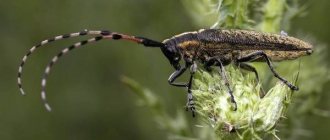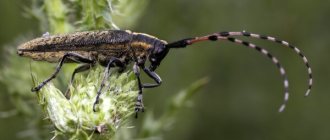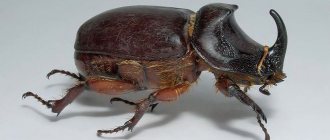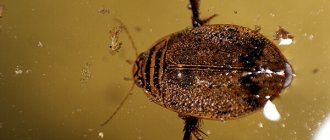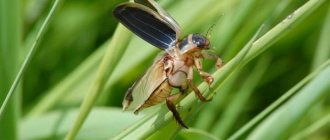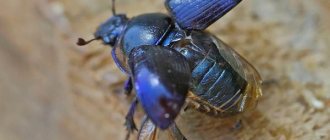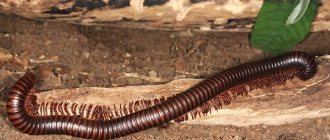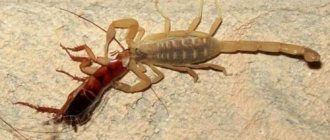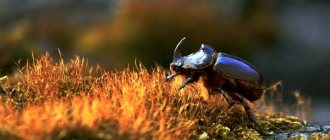Author: Elena N. https://floristics.info/ru/index.php?option=com_contact&view=contact&id=19 Category: Plant Pests Published: August 6, 2017Last edits: October 28, 2020
- Sawfly on roses
True sawflies are a family of sessile-bellied hymenopteran insects from the group of sawflies, which includes about 400 genera and more than 5000 species. Many species of sawflies are pests of forests and agricultural crops. Representatives of the family are distributed throughout the world, but more of them are in countries with temperate and cold climates: for example, in Finland there are more than 700 species, and in Russia - more than 2000. And very few species live in Australia and South America.
Sawfly reproduction
The adult sawfly shown in the photo does not live long. The main purpose of her life is reproduction. During the season, the female lays eggs 3-4 times, 30-50 pieces each. Cutting the soft parts of plants with her sharp ovipositor, she lays eggs in a pocket and seals the hole so that the larvae do not die prematurely.
The larva, compared to the adult insect, is much larger in size. Its length is 25-45 mm. Immediately after hatching, the larvae begin to eat leaves and fruits of trees and bushes, leaving only veins on the leaves.
The larval stage, false caterpillars, as they are also called, lasts for almost a month. They live mostly in groups. In case of danger, they take a funny pose in the shape of the letter S.
Having eaten, the grown caterpillars descend to the ground and pupate to become an adult insect. By mid-summer, a new generation of sawflies emerging from cocoons will begin to look for a place to breed. And so on until the fall.
Birch
An adult is usually 2-2.5 cm in length , the head, paws and body in the sternum area are dark, the abdomen itself is orangeish or reddish-brown, with reflections. At the top of the head the head is widened, the mandibles are large.
The black antennae widen towards the tips and take on a club-shaped, bright orange color. The wings are completely transparent, and have dark markings along the edges. Adults hatch in May-June.
The larvae grow up to 4.5 cm and are light green or light green in color. A thin black stripe with a yellowish edging stretches along the back. They have 11 pairs of abdominal legs and a large light yellow head. They can often be seen between July and September at the roots and in the upper parts of birch branches. As in the case of adult individuals, the larvae’s diet consists only of birch leaves.
To protect birch plantings it is necessary:
- Carefully dig up the soil near the rhizomes in the pre-winter period.
- All larvae found (sometimes in dark brown cocoons) are destroyed.
- In the summer, birch groves are sprayed with insecticides (“Chlorophos”, “Metaphos”), starting in June, to repel adult sawflies, and at the end of July - larvae.
Types of sawfly
Sawflies are divided into subspecies, depending on their habitat and food preferences. Let's look at some of them:
Apple fruit sawfly
Apple fruit sawfly - during the flowering period of early varieties of apples, this species of sawfly begins to grow years old. The female lays her eggs one at a time in each flower. In her short life, she can lay 50-80 eggs. She lives no more than a week. By some kind of inner natural instinct, she always chooses a flower that is pollinated.
After hatching, the caterpillars gnaw through the passage to the seed chamber of the fruit and destroy it. One larva is capable of eating 5-7 apples, which then fall to the ground. And by this time the larva will be ready to pupate.
Cherry slimy sawfly
The cherry slimy sawfly - despite its main diet, does not refuse cherries, pears, apples or plums. The insect's summer is at the end of May. Due to the fact that the female lives only a week, she is immediately ready to lay eggs.
For each egg, the caring mother chooses a new leaf and lays up to 70 eggs. Already in early August, the next generation of cherry slimy sawfly emerges from the pupae. Cherry leaves look scorched after a sawfly attack.
Rapeseed sawfly
Rapeseed sawfly - a yellow-orange insect lays its eggs in young shoots of cabbage, radish, rapeseed, lettuce, and radish. As a result of damage caused by the sawfly larva, fruits do not form on the plants. Gray-green larvae, only 25 mm in size, can destroy up to 90% of the crop.
Gooseberry sawfly
The gooseberry sawfly looks a lot like a small bee. He prefers gooseberry bushes, but does not refuse currants. Gray-blue or pale green larvae can destroy the entire gooseberry bush. After a sawfly invasion, the bush may no longer survive the winter.
Sawfly on roses
The sawfly on roses feeds not only on these beautiful flowers, but also spoils raspberries and strawberries. If the plant suddenly begins to dry out, it means that a sawfly larva has entered the stem. You can check this by cutting the stem of the plant. If passages are visible, then urgent measures must be taken.
Spruce
This is a small ( 5-6 mm in length ) almost completely black insect with long, thin antennae, where the yellow parts of the body are the mouthparts, abdomen and frontal veins of the wings. Can be found from April to June.
Light green, almost pine-like, black-eyed larvae have 3 pairs of sharp dark legs at the beginning of the body and 7 pairs of false legs in the rest. They grow up to 1-1.5 cm in length . They actively feed on young needles from May to June, after which they seek refuge in the forest floor for pupation.
These insects seriously damage many types of coniferous trees, causing their growth to be inhibited.
To prevent serious outbreaks of sawfly reproduction, pine needles need to be sprayed with special preparations against young larvae. It is useful to dig up the so-called tree trunk circles to detect and eliminate nests of larvae.
How to get rid of sawfly and its larvae
Experienced gardeners use a range of measures to combat sawflies and their army of larvae. Both folk remedies and special chemicals help fight these insects.
The following preventive measures help reduce the number of pests:
- loosening the soil in the spring and digging in the fall;
- shaking the plants daily;
- recycling of carrion;
- removal of damaged plants;
- spraying with tar soap solution;
- weeding;
- periodic spraying with insecticides.
Plants are treated with chemicals in two stages. The first spraying is carried out when the first foliage appears. The second spraying is after 14 days. During flowering, it is strictly forbidden to spray plants.
The most common remedy for sawfly is karbofos. However, it is recommended to alternate insecticides to avoid addiction to the product. You can use products such as DDT, Kinmiks, Iskra.
Treatment of the consequences caused by the sawfly consists of pruning and removing damaged shoots. It is best to burn damaged ovaries, branches and leaves so that the larvae cannot develop further. It is also recommended to use tree catching belts and special glue.
As a preventive measure, gardeners use infusions of chamomile, wormwood, garlic, pine needles or wood ash for spraying.
Common pine
Possessing a large oval-shaped body, adults grow up to 1 cm in length . The body is dark yellow or brownish in color, covered with black markings on the back and sternum. The antennae are black, short, and resemble a file. The male is completely black, thinner than the female, and has feathery black antennae and yellow paws.
The pale yellow larvae are large, 2.5-2.9 cm , with 8 pairs of pseudopods, each of which has a dark spot above it. The head is dark brown or black. For the winter they go into the soil near pine trees or under the forest floor.
Whole groups eat pine needles to the very base . As a result, the trees weaken, the upper parts dry out completely, and other pests easily penetrate the trunks.
Of the natural pest control measures, the safest are raising anthills and feeding birds that are enemies of sawflies . It is imperative to carry out timely spraying of pine trees with insecticides and biological products .
IMPORTANT: The most resistant to the attack of the common sawfly is the Crimean pine species. When organizing new plantings, it is better to give preference to it.
More information about pine sawflies here.
Chamomile infusion
1 kg of chamomile is crushed and poured with a bucket of hot water (70-80°C). Leave the solution for a day. Next, dilute the infusion with water 1:1, add liquid soap and treat the plants.
Such products can be used if there are very few pests on the site. To scare adult sawflies away from currant or gooseberry bushes, gardeners plant tomatoes or tansy between them.
If you notice a dangerous sawfly pest on your property, do not waste time. Be the first to start the fight so that you don’t have to recapture the territory from this terrorist.
Bread
The grain sawfly, also known as the stem sawfly, is not a pleasant neighbor. A narrow black insect up to 1 cm long , with shiny light yellow stripes and marks on the back. The paws are black, with the exception of the tips of the front pair - they are yellow.
Adults feed on nectar and weed pollen. The larva is watery-yellow, lacks obvious legs, and is 12-14 mm long . The head is light brown, and at the end of the body there is a small process bordered by 6-9 miniature spines.
The main damage caused by insects is to grain crops: wheat , rye , barley and even oats . The larvae eat away the contents of the stems, moving towards the roots, which weakens the plants and makes them brittle. When harvesting, the stems easily break off, the spikelets weaken and dry out.
Deep autumn plowing and double stubble peeling (immediately after harvest) are extremely necessary Early separate harvesting would be a good preventative measure . Culture preparations can be treated with “ Break ” or “ Borey ”.
ATTENTION: Do not forget about regular destruction of weeds on the site. In this way, owners of tree and shrub plantings will deprive adult individuals of some sawfly species of their source of nutrition – nectar and weed pollen.
Not only sawflies can be pests. Read our materials about shrews, bedbugs, moles, mole crickets, woodlice, ants, mice, nematodes, locusts, slugs.
Photo of Sawfly
Rapeseed
6-8 mm in size , elongated, deep orange in color, with a drooping black head and short black antennae.
Parts of the segments on the legs have black markings, the edges of the dark transparent wings are black, on the chest there are two large volumetric spots of black color, cast with highlights.
The larvae are black, faded greenish on the sides, and can reach a size of up to 2.5 cm in length.
The main damage is caused to cabbage crops , such as rapeseed , rutabaga , turnips , radishes , and sometimes they eat radish and turnip leaves . To prevent the development of larvae into pupae, deep plowing of the soil in the pre-winter period and measures against weeds are necessary.
Treatment of rapeseed plantings with Actellik and other insecticides will help against the massive spread of false caterpillars as soon as the first larvae are noticed on 5-10% of all plantings.
What is the habitat
The sawfly lives on almost all continents. Prefers cold or temperate climates. In Russia it occupies damp and shady forests.
Read on topic:
Features of the life activity of ladybugs
14.11.2020
Description of chironomids and their possible danger to humans
14.11.2020
What do cutworms look like and what harm do they cause?
14.11.2020
What do goliath beetles look like and can they be bred at home?
14.11.2020
For food they choose:
- fruit trees;
- berry bushes;
- ornamental plants.
There is a low probability of encountering the beetle in areas with a hot and dry climate.
Causes of defeat
The main reasons are drought, warm autumn and the love of insects for herbaceous plants. Human negligence does not play a special role here. Sawflies spread by migration, leaving millions of offspring. Caterpillars survive in any conditions, safely devouring all crops.
Insects are attracted to the content of pungent or bitter alkaloids in the leaves of gooseberries, red and black currants. The gardener is only required to destroy the brood and carry out preventive measures.
Damage
The mouthparts of sawflies are designed for chewing. Most sawflies are, to a certain extent, dependent on their owner. The elm sawfly feeds on elm and willow. Conifer sawflies (such as the Scots pine sawfly, Neodiprion taedae linearis Ross) can sometimes cause serious injury to pine trees and other evergreens by feeding on foliage, bud tunnels, or dull shoots. The larvae of the black-headed ash sawfly, Teuthida cordigera (Beauvois) and the brown ash sawfly, Tomostethus multicinctus (Rohwer) feed on red and white ash. Common sawfly larvae feed together (socially) and can keep their abdomen curled up along the edge of a leaf. On broad-leaved tree leaves, the larvae usually feed on the underside of the leaf. On oak trees, Caliroa spp. the larvae skeletonize the leaves, while the pecan sawfly larvae produce round holes of varying sizes in the leaf tissue. Adults can be found on flowers.
Weaver single
13-17 mm long , with a black-yellowish abdomen, black sternum, head and antennae. The tip of the abdomen has a large black mark. The wings are translucent, faded yellow.
The larva is gray-green with a dark stripe along the back, the head is also light green, sometimes with a brownish tint. Can reach a length of 2.5 cm . There are 6 thin legs on the chest and one pair of pseudolegs at the tail.
They weave web nests on pine branches that look like elongated brown cone-shaped formations. False caterpillars eat needles, leaving small stumps and excrement.
It is better to cut off and destroy spider nests immediately upon detection, and in case of a large outbreak of the spread of larvae, spraying with insecticides against younger instars is standard.

